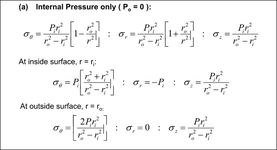PipesAndStuff
Civil/Environmental
- Apr 18, 2025
- 4
Hello,
I'm determining the change in length of an 8-inch (DIPS) SDR11 HDPE pipe after pressurizing due the Poisson effect. I'm treating the pipe as a thick walled cylinder since the pipes diameter/thickness < 20.
I'm using the attached equations to compute axial, tangential, and radial stresses. Then computing the axial strain and multiplying by the pipe's length.
Here are the parameters:
Poison Ratio = 0.45
Elastic Modulus = 150,000 psi
Inside Radius = 3.7 inches
Outside Radius = 4.5 Inches
Inside Pressure = 180 psi
Pipe Length = 1000 ft
When I compute the stress for the inside wall of the pipe, I get a change in length of 29.1 Inches.
When I compute the stress for the outside wall of the pipe, I get a change in length of 2.9 inches.
I'm not sure which result to use or if I am approaching this problem correctly. I appreciate any insight people have for this problem.
Thanks,
Tony
I'm determining the change in length of an 8-inch (DIPS) SDR11 HDPE pipe after pressurizing due the Poisson effect. I'm treating the pipe as a thick walled cylinder since the pipes diameter/thickness < 20.
I'm using the attached equations to compute axial, tangential, and radial stresses. Then computing the axial strain and multiplying by the pipe's length.
Here are the parameters:
Poison Ratio = 0.45
Elastic Modulus = 150,000 psi
Inside Radius = 3.7 inches
Outside Radius = 4.5 Inches
Inside Pressure = 180 psi
Pipe Length = 1000 ft
When I compute the stress for the inside wall of the pipe, I get a change in length of 29.1 Inches.
When I compute the stress for the outside wall of the pipe, I get a change in length of 2.9 inches.
I'm not sure which result to use or if I am approaching this problem correctly. I appreciate any insight people have for this problem.
Thanks,
Tony


